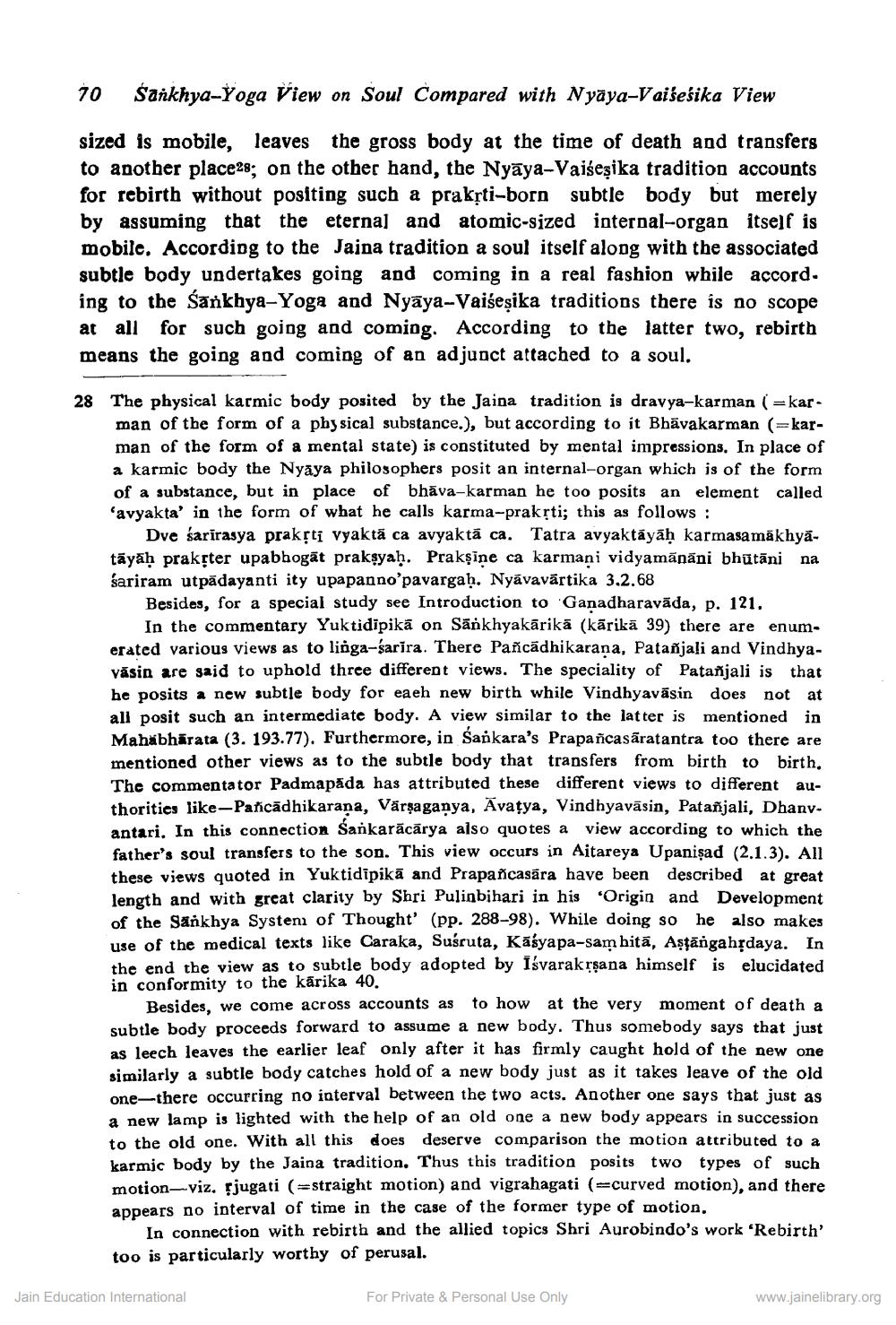________________
Sankhya-Yoga View on Soul Compared with Nyaya-Vaiseśika View
sized is mobile, leaves the gross body at the time of death and transfers to another place28; on the other hand, the Nyāya-Vaiśeṣika tradition accounts for rebirth without positing such a prakṛti-born subtle body but merely by assuming that the eternal and atomic-sized internal-organ itself is mobile. According to the Jaina tradition a soul itself along with the associated subtle body undertakes going and coming in a real fashion while accord. ing to the Sankhya-Yoga and Nyaya-Vaiśeṣika traditions there is no scope at all for such going and coming. According to the latter two, rebirth means the going and coming of an adjunct attached to a soul.
70
28 The physical karmic body posited by the Jaina tradition is dravya-karman (=karman of the form of a physical substance.), but according to it Bhāvakarman (=karman of the form of a mental state) is constituted by mental impressions. In place of a karmic body the Nyaya philosophers posit an internal-organ which is of the form of a substance, but in place of bhava-karman he too posits an element called 'avyakta' in the form of what he calls karma-prakṛti; this as follows:
Dve sarirasya prakṛti vyaktă ca avyaktā ca. Tatra avyaktāyāḥ karmasamakhyātāyāḥ prakṛter upabhogat prakṣyaḥ. Prakṣine ca karmani vidyamānāni bhūtāni na sariram utpādayanti ity upapanno'pavargaḥ. Nyāvavārtika 3.2.68
Besides, for a special study see Introduction to Gaṇadharavada, p. 121.
In the commentary Yuktidipika on Sānkhyakārikā (kārikā 39) there are enumerated various views as to linga-sarira. There Pañcādhikaraṇa, Patanjali and Vindhyavasin are said to uphold three different views. The speciality of Patanjali is that he posits a new subtle body for each new birth while Vindhyavasin does not at all posit such an intermediate body. A view similar to the latter is mentioned in Mahabharata (3. 193.77). Furthermore, in Sankara's Prapañcasaratantra too there are mentioned other views as to the subtle body that transfers from birth to birth. The commentator Padmapăda has attributed these different views to different authorities like-Pañcadhikarana, Värṣaganya, Avatya, Vindhyavasin, Patanjali, Dhanvantari. In this connection Sankarācārya also quotes a view according to which the father's soul transfers to the son. This view occurs in Aitareya Upanisad (2.1.3). All these views quoted in Yuktidīpikā and Prapañcasara have been described at great length and with great clarity by Shri Pulinbihari in his 'Origin and Development of the Sankhya System of Thought' (pp. 288-98). While doing so he also makes use of the medical texts like Caraka, Suśruta, Kasyapa-sam hita, Astangahṛdaya. In the end the view as to subtle body adopted by Isvarakṛṣana himself is elucidated in conformity to the karika 40.
Besides, we come across accounts as to how at the very moment of death a subtle body proceeds forward to assume a new body. Thus somebody says that just as leech leaves the earlier leaf only after it has firmly caught hold of the new one similarly a subtle body catches hold of a new body just as it takes leave of the old one-there occurring no interval between the two acts. Another one says that just as a new lamp is lighted with the help of an old one a new body appears in succession to the old one. With all this does deserve comparison the motion attributed to a karmic body by the Jaina tradition. Thus this tradition posits two types of such motion-viz. fjugati (straight motion) and vigrahagati (=curved motion), and there appears no interval of time in the case of the former type of motion.
In connection with rebirth and the allied topics Shri Aurobindo's work 'Rebirth' too is particularly worthy of perusal.
Jain Education International
For Private & Personal Use Only
www.jainelibrary.org




